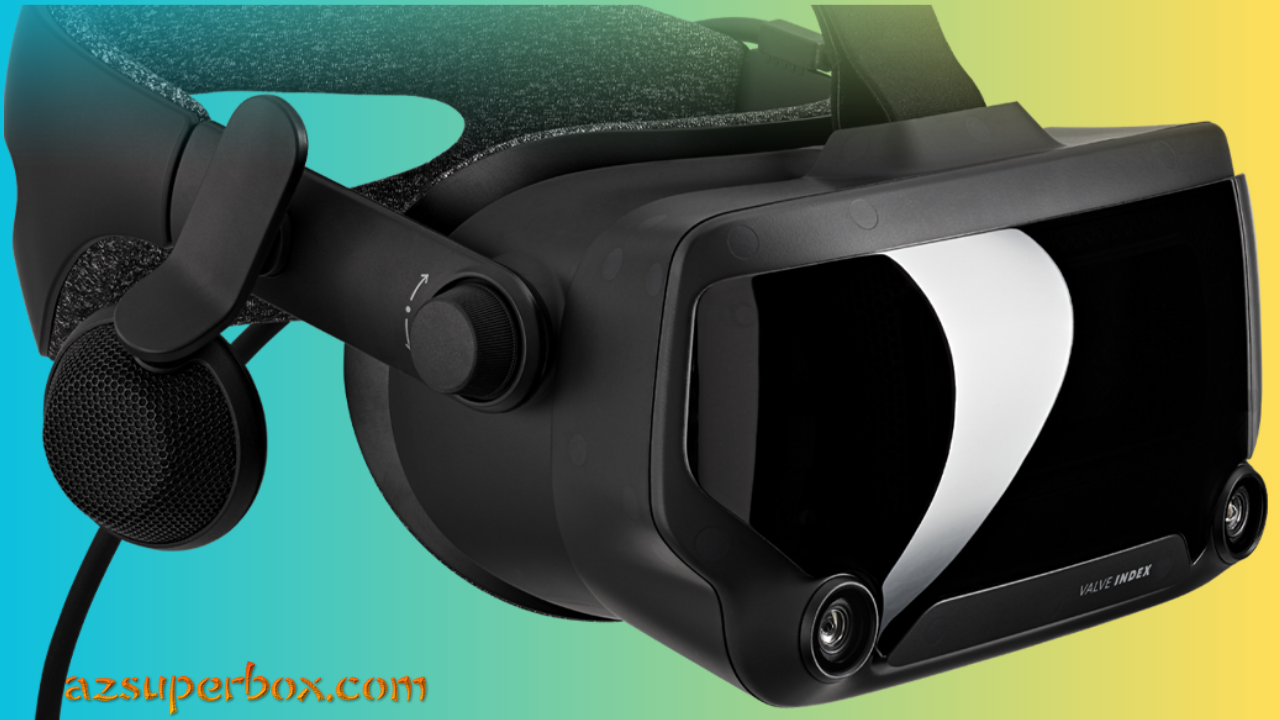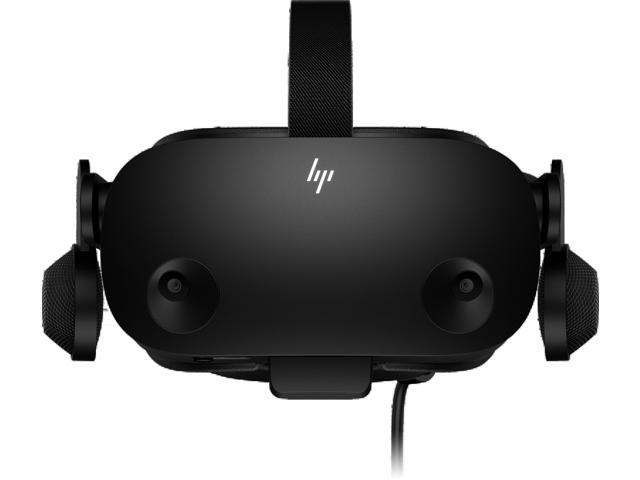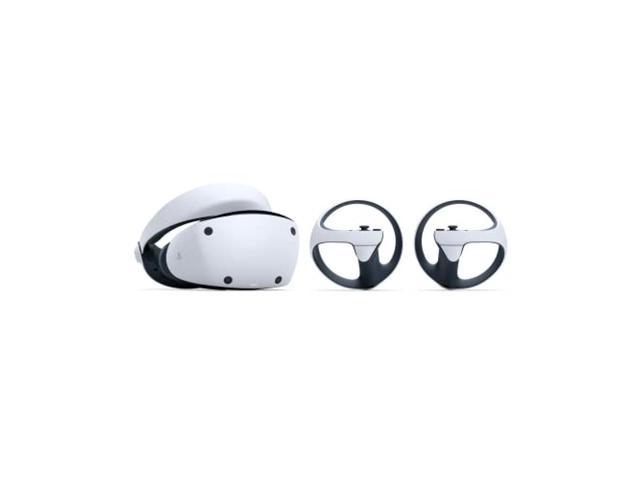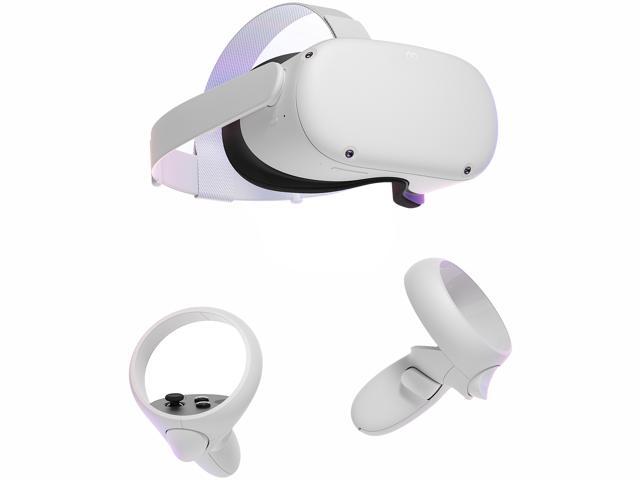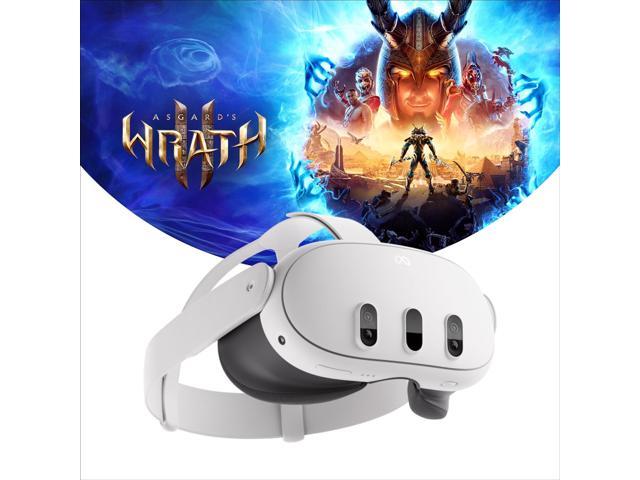This post contains affiliate links. AZSuperbox.com is a participant in the Amazon Services LLC Associates Program, an affiliate advertising program designed to provide a means for sites to earn advertising fees by advertising and linking to Amazon.com. As an Amazon Associate, I earn from qualifying purchases.
THE BEST VR HEADSETS
In this year, virtual reality (VR) technology continues to advance, providing immersive experiences for gaming, entertainment, and professional applications. The best VR headsets offer cutting-edge features, comfort, and high-quality visuals to transport users into virtual worlds. In this guide, we unveil the top VR headsets that excel in performance, design, and versatility. Whether you’re a gamer, a content creator, or someone interested in VR for work, these headsets cover a range of needs and preferences. Join us as we explore the forefront of VR headset technology and present the top choices that promise to deliver captivating virtual experiences. Dive into the world of immersive computing with these outstanding VR headsets that offer a glimpse into the future of digital interaction and entertainment.
Meta Quest 3 Virtual Reality Headset
Meta Quest 2 Virtual Reality Headset
Sony PlayStation VR2 (PSVR2) Virtual Reality Headset
HP Reverb G2 Virtual Reality Headset
Valve Index VR kit

The Valve Index Virtual Reality Headset is a portal to immersive worlds, offering a high-fidelity virtual reality experience. The kit includes everything needed for a complete VR experience, such as the headset with integrated headphones, controllers, base stations, and all necessary cables and adapters. A standout feature of the Valve Index is its compatibility with “Half-Life: Alyx,” a game included for free with the purchase. Owners will also enjoy exclusive bonuses like special gun skins and themed content for other games, adding value to their VR experience.
Setting up the Valve Index is straightforward, guided by a comprehensive setup guide. The system is designed for comfort and adjustability, catering to various head sizes and preferences with a cradle adapter and face gasket. The dual controllers, equipped with lanyards and charging cables, are intuitively designed for natural and precise interaction within VR environments.
The Valve Index requires a compatible PC, with minimum system requirements including Windows 10, a dual-core processor with hyper-threading, 8 GB RAM, and a capable graphics card like the NVIDIA GeForce GTX 970 or AMD RX480. A stable broadband internet connection is also necessary for the best experience.
Included in the kit are two SteamVR 2.0 base stations, which provide precise tracking and movement within the virtual space. These base stations come with long power cables and stands, ensuring flexible setup options to suit different room sizes. For maintenance, a cleaning cloth is provided to keep the headset and lenses in pristine condition.
In summary, the Valve Index Virtual Reality Headset offers a premium VR experience with its comprehensive kit, easy setup, and immersive features. It’s a gateway to virtual worlds, enhanced by its exclusive content and compatibility with popular VR titles, making it a top choice for virtual reality enthusiasts.
The HP Reverb G2 Virtual Reality Headset is a remarkable piece of technology, setting a new standard in the realm of virtual reality. Developed in collaboration with Valve and Microsoft, this headset is designed to deliver an immersive experience that doesn’t compromise on any front. It boasts realistic visuals and immersive soundscapes, achieved through industry-leading lenses and speakers provided by Valve. The headset features mura-free LCD panels offering a resolution of 2160 x 2160 per eye, allowing users to see more detail than ever before.
Ergonomically designed, the HP Reverb G2 is built for comfort, making it suitable for extended use. It offers a custom fit for every user, thanks to its flexible material, increased cushion size, and adjustable lenses for different eye distances. This ensures maximum comfort regardless of face size and shape.
One of the standout features of the HP Reverb G2 is its superior tracking capabilities. Equipped with four cameras built into the headset, it requires no external sensors, enabling it to track more movements, no matter how extreme. The controllers have been redesigned to be smaller and more ergonomic, enhancing the natural feel and comfort during use.
The headset is highly compatible across various platforms, offering access to both SteamVR and Windows Mixed Reality content. This wide-ranging compatibility ensures that users have seamless access to a vast array of VR experiences. The setup process is quick and painless, adding to the user-friendly nature of the device.
In terms of technical specifications, the HP Reverb G2 is compatible with Windows 10 May 2019 update or higher. It requires a processor equivalent to or better than an Intel Core i5, i7, Intel Xeon E3-1240 v5, or AMD Ryzen 5, along with a minimum of 8 GB RAM. For graphics, it supports a range of cards from NVIDIA GeForce GTX 1080 to RTX 3090 and AMD Radeon RX 5700 to Radeon Pro WX 9200, ensuring smooth performance at full or half resolution.
The headset is relatively lightweight, weighing just 1.21 lb, making it easy to wear without causing fatigue. It comes with a one-year limited warranty, which covers parts but not labor. In the box, users will find the VR headset, a 6m headset cable for desktop and mobile PCs, two motion controllers, adapters, and a power adapter, along with a setup document.
In summary, the HP Reverb G2 Virtual Reality Headset offers an unparalleled VR experience, combining exceptional visuals, sound, comfort, and compatibility. Its advanced tracking, ergonomic design, and wide range of supported hardware make it a top choice for VR enthusiasts looking for a high-quality, immersive experience.
The Sony PlayStation VR2 Virtual Reality Headset marks a new era in virtual reality gaming. It incorporates innovative PlayStation VR2 Sense technology, which brings gaming to life with subtle headset vibrations, immersive 3D audio, and intelligent eye tracking. This headset also features finger touch detection, haptic feedback, and adaptive triggers on the PS VR2 Sense controller, creating a deeply engaging gaming experience.
The headset offers a sense of believability like never before, allowing players to truly feel a new dimension of play. This is further enhanced with the smart design of the new PS VR2 Sense controller. Its orb design provides precision control and enables players to make precise movements and gestures, enhancing the interactive experience. The analog sticks and action buttons, along with a ‘grip’ button, allow for intuitive interaction with the virtual environment.
The PlayStation VR2 Headset is designed with comfort and immersion in mind. It features inside-out tracking, enabled by four built-in tracking cameras that capture every movement without needing an external camera. The Fresnel lens is light and balanced, with vents to reduce fogging and adjustable straps for a perfect fit. The headset is easy to set up, requiring just a single USB cable plugged into the PS5 console. Players can customize their play area, dive into games, enjoy non-VR content in Cinematic Mode, or use the See-through View function to check their surroundings.
The headset’s library includes a range of immersive games like ‘Resident Evil Village™’, ‘The Walking Dead: Saints & Sinners – Chapter 2: Retribution’, ‘No Man’s Sky™’, and ‘Star Wars: Tales from the Galaxy’s Edge – Enhanced Edition’, among others. These games showcase the VR2’s capabilities, offering unique experiences in diverse virtual worlds.
In summary, the Sony PlayStation VR2 Virtual Reality Headset offers an unparalleled virtual reality experience. Its innovative technology, precision control, comfortable design, and diverse game library make it a standout choice for gamers looking to immerse themselves in new, virtual worlds.
The Meta Quest 2 Virtual Reality Headset marks a revolutionary step in immersive entertainment and interactive experiences. It’s designed to transport users into a world of endless possibilities, from battling with friends to attending live events or working out in extraordinary settings. The headset is powered by a super-fast processor and features a high-resolution display that ensures a seamless and smooth experience, even during high-speed action. This performance is further enhanced by 3D positional audio, hand tracking, and haptic feedback, creating a deeply immersive experience where virtual worlds feel incredibly real.
One of the most striking features of the Meta Quest 2 is its complete wireless design. It eliminates the need for wires, offering absolute freedom to explore virtual realities. The headset includes internal tracking and a built-in battery, providing everything needed for VR exploration in one device. The intuitive Touch controllers of the Meta Quest 2 translate natural movements directly into virtual reality, allowing for realistic interactions whether you’re in a zero gravity arena or a virtual workspace.
Safety is also a key aspect of the Meta Quest 2 experience. The Guardian boundary system lets users define their play space and sends alerts if they get too close to the edge. This feature ensures safety, even when engaging in adventurous missions in fantasy worlds. The headset is designed for comfort, with a light and easily adjustable build, including a padded interface to keep distractions at bay while you’re meditating, collaborating, or floating through space.
The Meta Quest 2 is a gateway to an expanding universe of over 350 titles across various genres like gaming, social/multiplayer, and entertainment. It offers unique VR experiences and exclusive blockbuster releases. The headset is suitable for users aged 13 and up, with certain apps, games, and experiences tailored for a more mature audience.
In terms of productivity, the Meta Quest 2 redefines the concept of a workspace. You can collaborate in real-time, meet virtually face-to-face, or find focus in distant, imaginative locations. It also introduces a new dimension to fitness, offering a supportive community, real-life coaches, and the chance to work out in exotic locations, making fitness fun and engaging.
For social interactions, the Meta Quest 2 allows users to do incredible things together from almost anywhere. It’s a platform for exploring new worlds, creating, and collaborating in virtual reality. In gaming, the headset takes the experience beyond just playing games – it allows users to explore virtual worlds with unprecedented freedom, responding to every move in real-time.
The technical specifications of Meta Quest 2 include an optional PC connection, allowing users to enjoy advanced all-in-one VR or connect to a gaming computer for additional titles. The graphics are enhanced with increased pixel density for smoother gameplay, and the Six Degrees of Freedom tracking translates head and body movements into VR with realistic precision. The redesigned Touch controllers feature improved ergonomics and a new thumb rest for added stability.
In terms of optics, the Meta Quest 2 boasts a Fast-Switch LCD display with a resolution of 1832 x 1920 per eye, supporting refresh rates of 60, 72, and 90 Hz. It’s also glasses compatible. The headset includes built-in positional audio and a 3.5 mm audio port for optional headphone use.
Storage options for the Meta Quest 2 include 128GB or 256GB, providing ample space for apps and games. The headset’s safety features include the Guardian system for tracing a safe play area and a passthrough function for an awareness of the real-world surroundings. Users can share their experiences by casting directly to an enabled TV or phone, and they can join a growing community of VR enthusiasts.
In conclusion, the Meta Quest 2 Virtual Reality Headset offers a powerful and immersive VR experience, blending cutting-edge technology with user safety, comfort, and a vast library of content. It’s a platform that brings gaming, social interaction, fitness, and productivity into a new, exciting dimension, appealing to a wide range of users and offering experiences that go beyond the conventional.
The Meta Quest 3 Virtual Reality Headset marks a significant leap in home entertainment, offering a transformative mixed reality experience. It comes equipped with the Snapdragon XR2 Gen 2 chipset, which doubles the GPU processing power compared to its predecessor, the Meta Quest 2. This upgrade ensures smoother gameplay, faster load times, and support for more demanding applications. The headset offers two storage options, 128GB and 512GB, allowing users to delve into a vast library of over 500 immersive experiences that include gaming, fitness, and entertainment, all with the benefit of backwards compatibility.
One of the standout features of the Meta Quest 3 is its mixed reality capability, powered by 2 RGB cameras with 18 PPD. This technology offers 10 times the resolution of the Quest 2 and three times that of the Quest Pro in passthrough, providing full-color, high-fidelity views of the surroundings while blending virtual objects seamlessly into the physical space. The audio experience is equally impressive, featuring integrated stereo speakers with 3D spatial audio that’s 40% louder and offers an enhanced bass range for an immersive sound experience.
Regarding ergonomics, the Meta Quest 3 is designed for comfort. It weighs 515 grams and features pancake optics for a slimmer profile, making it more comfortable to wear. The display resolution of 2064×2208 pixels per eye enhances clarity and graphics, offering a 4K+ Infinite Display with 25PPD and 1218 PPI. Users can enjoy a wide field of view, with 110 degrees horizontal and 96 degrees vertical, extending peripheral vision for a deeply immersive experience.
The Touch Plus controllers of the Meta Quest 3 are a highlight, offering a ring-free design for more natural movement and precise input. These controllers provide TruTouch variable haptics for a range of tactile feedback, enhancing the realism of virtual environments. The headset also supports direct touch hand tracking for more intuitive control without the need for controllers.
As for the content library, users have access to over 500 titles, including options for gaming, social interaction, fitness, and more. The headset also supports PC connectivity with the Meta Quest Link Cable and Air Link, further expanding the range of experiences. In terms of battery life, users can expect up to 2.2 hours of usage on average, with the battery life varying based on the type of activity.
Lastly, the Meta Quest 3 emphasizes user privacy and safety. It includes advanced encryption and customized settings for data sharing, along with an external LED signal to notify bystanders when the cameras are in use. This makes the Meta Quest 3 not just a powerful tool for entertainment and exploration, but also a secure and user-friendly device for the whole family.
Diving into the Virtual Realm: A Guide to Virtual Reality Headsets
In the ever-evolving landscape of technology, virtual reality (VR) has emerged as a groundbreaking medium, offering immersive experiences that transport users to virtual worlds. At the heart of this revolution are virtual reality headsets, devices designed to provide a sensory-rich, 3D experience. Whether you’re a gaming enthusiast, a content creator, or someone eager to explore new frontiers in entertainment and education, this guide will help you navigate the diverse world of virtual reality headsets.
A. Understanding Virtual Reality Headsets
1. Immersive Visual and Audio Experience:
- 360-Degree Environment: VR headsets use stereoscopic displays to create a 3D environment that surrounds the user, offering a sense of depth and presence.
- Spatial Audio: Some headsets incorporate spatial audio technology, enhancing the immersive experience by simulating 3D sound sources.
2. Tracking Systems:
- Positional Tracking: VR headsets often include tracking systems to detect the user’s movements in physical space, allowing for a more natural and interactive experience.
- Controllers: Hand controllers or motion sensors may accompany VR headsets, enabling users to interact with virtual objects.
B. Types of VR Headsets
1. Tethered VR Headsets:
- Connected to a PC or Console: Tethered headsets are connected to a computer or gaming console, providing high-end graphics and processing power.
- Examples: Oculus Rift, HTC Vive, PlayStation VR.
2. Standalone VR Headsets:
- Integrated Processing Unit: Standalone headsets have built-in processors and don’t require external devices for operation, offering greater portability.
- Examples: Oculus Quest, HTC Vive Focus.
3. Smartphone-Based VR Headsets:
- Uses a Smartphone as a Display: These headsets leverage the user’s smartphone as the display and processing unit.
- Examples: Google Cardboard, Samsung Gear VR.
C. Key Features of Virtual Reality Headsets
1. Display Resolution:
- Clarity of Visuals: Higher display resolution contributes to sharper and more detailed visuals, reducing the “screen door effect” common in earlier VR headsets.
2. Field of View (FoV):
- Immersive Perspective: A wider field of view enhances the sense of immersion by expanding the user’s peripheral vision within the virtual environment.
3. Refresh Rate:
- Smooth Motion: A higher refresh rate results in smoother motion within the virtual world, reducing motion sickness for users.
4. Comfort and Ergonomics:
- Weight Distribution and Padding: Comfortable head straps, well-distributed weight, and soft padding contribute to an enjoyable and extended VR experience.
5. Content Ecosystem:
- Diverse Library: The availability of a rich and diverse content library is crucial for a satisfying VR experience. Consider the range of games, apps, and experiences offered.
D. Considerations When Choosing a VR Headset
1. Purpose of Use:
- Gaming, Education, or Productivity: Identify the primary use of the VR headset. Gaming headsets may prioritize high refresh rates, while educational headsets might focus on content variety.
2. Compatibility:
- Platform and Device Compatibility: Ensure that the VR headset is compatible with your gaming console, PC, or smartphone.
3. Setup and Ease of Use:
- User-Friendly Setup: Consider the ease of setup, especially for tethered headsets. Some users may prefer plug-and-play options for a hassle-free experience.
4. Budget:
- Affordability: VR headsets come at various price points. Determine your budget and explore options that offer the best features within that range.
E. Applications of Virtual Reality Headsets
1. Gaming:
- Immersive Gaming Experiences: VR gaming offers a new level of immersion, allowing players to step into virtual worlds and interact with environments and characters.
2. Education and Training:
- Simulations and Training: VR is utilized in education for immersive simulations and training scenarios, providing hands-on experiences in a virtual environment.
3. Healthcare:
- Therapeutic Applications: VR is used in healthcare for therapeutic purposes, including pain management, exposure therapy, and rehabilitation.
4. Design and Architecture:
- Virtual Prototyping: Architects and designers use VR to create virtual prototypes and walkthroughs, visualizing spaces before construction.
F. Emerging Trends in Virtual Reality Headsets
1. Wireless Technology:
- Enhanced Mobility: Advancements in wireless technology aim to eliminate the need for cables, providing greater freedom of movement for users.
2. Eye-Tracking and Foveated Rendering:
- Improved Graphics Performance: Eye-tracking technology and foveated rendering focus graphics processing on the user’s point of gaze, enhancing visual quality and performance.
3. Augmented Reality (AR) Integration:
- Blending Virtual and Real Worlds: Some headsets are exploring the integration of AR features, blending virtual and real-world elements for a mixed reality experience.
G. Conclusion
Virtual reality headsets represent a gateway to immersive experiences, offering a glimpse into the possibilities of digital realms. Whether you’re a gamer, an educator, or a professional seeking new ways to engage with content, choosing the right VR headset involves considering factors such as display quality, comfort, and the content ecosystem. Stay informed about emerging trends to anticipate the future of virtual reality and ensure your headset remains at the forefront of this dynamic and evolving technology. Embark on a journey into virtual worlds, where the boundaries between reality and imagination blur, and the extraordinary becomes the new norm.
